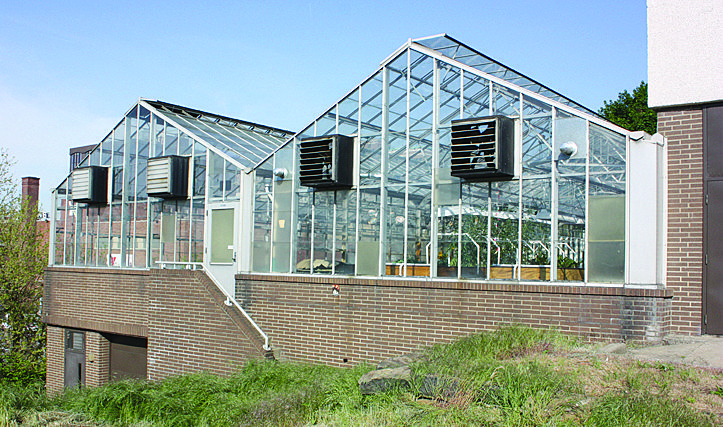YOUNGSTOWN — Seventeen-year-old Mike Jones of Youngstown, Ohio, picks green beans from several plants, suspended in water, in Choffin Career Center’s Aquaponics building.
He’s never grown vegetables before and may have never had the chance until a few months ago, when Choffin Career and Technical Center opened the doors to the school’s new aquaponics program, what school officials believe is the first aquaponics program of its kind in Ohio.
It’s a program that aspires to teach students practical knowledge of aquaponics, but also to bolster Youngstown’s burgeoning local food and urban farming scene.
What is ‘aquaponics?’
Aquaponics combines aquaculture (the farming of aquatic animals under controlled conditions) and hydroponics (the cultivation of plants in water) to create a closed system that uses a symbiotic relationship between fish and plants.
The fish provide nutrient-rich water for the plants to grow, then the plants filter the water for the fish to thrive.
Urban food producers find it useful because it has one major benefit over hydroponics, aquaculture and traditional farming: It wastes much less water.
According to Ralph Zerbonia, Choffin’s aquaponics system architect and owner of Aquaponitech, a Youngstown-based aquaponics design and supply company, a typical aquaponics system loses only 2 percent of its water supply via evaporation and plant absorption. The rest is continuously recycled through the system.
Additionally, since aquaponics can be implemented in a greenhouse, the risk for pests is lower. If pests do occur, however, nonchemical methods must be used to treat them. If pesticides make their way into the water system, they could harm or even kill the fish.
Getting involved

Zerbonia volunteered to spearhead the project’s design aspects when he heard Doug Hiscox, deputy superintendent of Youngstown City Schools, wanted to use Choffin’s vacant horticulture building as a place to house an aquaponics center. Hiscox was familiar with the subject from his days working as an administrator for the Bridgeport, Conn., school system, which has an aquaculture program in place.
Once the project was approved and construction was about to take place, volunteers from multiple disciplines came together to make it happen.
“Everybody has been involved in every level of the project,” said Renee English, Choffin spokeswoman. By everybody, English is referring to the students, teachers, school administrators and community volunteers who took the school’s vacant building and transformed it into a functional space over several months.
Taking root
The renovation of the building began in May 2012 with funding from a Carl D. Perkins Grant. Hiscox estimates the renovations cost $50,000.
Choffin’s Construction Academy, including the masonry and HVAC programs, started the process by gutting the building, cleaning the greenhouse and retrofitting the space for aquaponics.
The renovation was a learning lab for the students. Over the summer, with the direction of Zerbonia and construction instructor Kevin Sinkele, the teachers and their students built four 600-gallon rearing tanks and two grow beds, laid pipe and installed pumps to get the water flowing.
Thirty tilapia were purchased to kick-start the system. Seeds and other supplies were donated by Hartford Greenhouses.
Choffin’s aquaponics program was ready for its first 13 students by the beginning of the 2012-2013 school year.
Making progress

The program remains a work in progress. New additions are being made at a quick pace.
The greenhouse featured two growing beds at the beginning of the school year. Since then, two more beds have been added and a ventilation system was installed.
Another addition, a vertical growing feature, was added May 17. Once it’s complete, the vertical growers should support 84 strawberry plants.
More than 20 varieties of plants are grown in a float system, a method that keeps the plants suspended above the water, but lets their roots grow. The plants, including swiss chard, basil and green beans, are periodically sold at Youngstown’s Northside Farmers Market. Crops grown under a greenhouse using aquaponics can have as many as six harvest seasons, according to Zerbonia.
Students are responsible for harvesting the plants, testing the water, feeding fish and cleaning the biofilter.
These skills are marketable now and could be more marketable in the future. According to Laura Tiu, Ph.D, OSU Extension aquaculture specialist, there are over 200 fish farms in the state and interest is growing in aquaculture.
The students have also developed “spaghetti garden” pots, which they will take home over the summer. Each pot includes ingredients for spaghetti sauce: tomato, pepper, oregano, basil and onion.
Looking ahead
What’s next for the aquaponics program? The ultimate goal is to become a resource to the community.
“Next year, we’ll be growing a main crop and finding a market for it,” said Sarah Wilhelm, aquaponics instructor. She’s willing to grow anything local businesses and restaurants are interested in buying, and is currently working with the school’s culinary arts instructor to find local restaurants and businesses interested in locally grown produce.
The program’s first year made an impact on student Mike Jones, who will be returning to Choffin next school year. He admitted that, until he enrolled in the program, he’d never really grew anything before. Now, over the summer, Jones plans on starting his own landscaping business.













Would like more information about the program
Hi Mike, go ahead and send me an email at wflannigan@farmanddairy.com, I’ll answer all of your questions.
Will